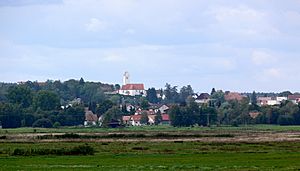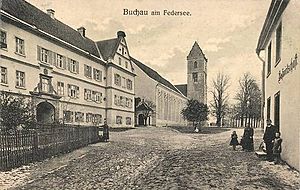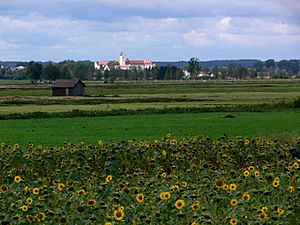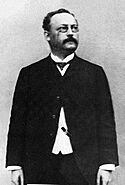Bad Buchau facts for kids
Quick facts for kids
Bad Buchau
|
||
|---|---|---|
 |
||
|
||
| Country | Germany | |
| State | Baden-Württemberg | |
| Admin. region | Tübingen | |
| District | Biberach | |
| Elevation | 592 m (1,942 ft) | |
| Population
(2022-12-31)
|
||
| • Total | 4,636 | |
| Time zone | CET/CEST (UTC+1/+2) | |
| Postal codes |
88422
|
|
| Dialling codes | 07582 | |
| Vehicle registration | BC | |
| Website | www.badbuchau.de | |
Bad Buchau is a small town in Germany. It is located in the state of Baden-Württemberg, near a lake called Federsee. About 4,000 people live there. The lake is separated from the town by a wide area of reeds.
Bad Buchau includes nine smaller villages and a few farm areas. The main language spoken is German. However, many people also speak a local dialect called Swabian.
For a long time, from the 1200s until 1803, Buchau was special. It was home to both an important Imperial Abbey (a type of monastery) and a Free Imperial City. This meant the town was independent and ruled itself. It was one of the smallest self-governing cities. Because it was like an island, it didn't need big city walls. But later, the water level of Lake Federsee was lowered, and Buchau lost its island-like protection.
Contents
History of Bad Buchau
Let's look at some important dates in Bad Buchau's history:
Early Beginnings
- AD 770 – The Buchau Abbey was started by a Frankish Count named Warin and his wife, Adelindis von Buchau. Today, a festival called "Adelindisfest" is named after her. The church from the abbey is still used as a local church.
- 819 and 857 – The Abbey received special gifts and support from Frankish Kings Louis the Pious and Louis the German.
- 902 – Countess Adelindis joined the Abbey. She is remembered as a kind helper and a saint. She and her sons are buried in the church.
- 1014 or 1022 – Buchau is first mentioned as a "Free Imperial City." This means it could make its own money and had a market.
Changes Over Time
- 1417 – The Abbey became a place for noble women from the Swabian area.
- 1577 – A Jewish community started living in the Free Imperial City. They became important under the city's protection.
- 1650 – A cemetery for the Jewish community was built.
- 1730 and 1837 – A synagogue (a Jewish place of worship) was built for the growing community.
- 1774–1776 – The main church was changed from an old Gothic style to a newer French classic style.
- 1787 and 1808 – The water level of Lake Federsee was lowered. People hoped to create more farmland, but this didn't work out. However, it did allow for new roads to be built.
Losing Independence and New Beginnings
- 1802/1803 – Both the Imperial Abbey and the Free Imperial City lost their independence. They became part of the land owned by the Prince of Thurn and Taxis.
- 1806 – Buchau became a town in the kingdom of Württemberg.
- 1807 – The Jewish community gained the right to own property.
- 1828 – The Jewish community received full civil rights.
- 1847 – Hermann Einstein, the father of the famous scientist Albert Einstein, was born here.
- 1896–1917 – A small railway line was built to connect Buchau to bigger train lines.
- 1911 – A wooden walkway was built to Lake Federsee, going through the reeds. Bad Buchau and the Lake Federsee area became famous for archaeological discoveries. One important find was the "Wasserburg Buchau," an old settlement from the late Bronze Age (around 1100-800 BC). A wildlife preserve was also created here.
- 1935 – An earthquake in Saulgau damaged many buildings in Bad Buchau.
- 1938 – During a terrible event called Kristallnacht, the synagogue was set on fire. The mayor ordered firefighters to put it out, but the next night, it was set on fire again and badly damaged. The stone blocks from the synagogue were later used to build roads.
- 1941–45 – During World War II, many Jewish people from Buchau were forced to leave their homes. Sadly, most of them did not return after the war.
- 1949 – A public spa opened in the town.
- 1963 – Buchau officially received the title "Bad," which means "Spa." So, it became known as Bad Buchau.
- 1968 – A new museum called the Federseemuseum opened. It has amazing exhibits about the Stone Age and Bronze Age, as this area has many old artifacts from those times.
- 1969 – The small railway line was finally closed down.
- 1963–1998 – Bad Buchau's spa grew a lot, adding a thermal spring and large spa gardens.
Town Leaders
Here are the mayors who have led Bad Buchau:
- 1948–1978: Hans Knittel
- 1979–2003: Harald Müller
- 2003 – present: Peter Diesch
World Heritage Site
The old settlement at Siedlung Forschner is a very special place. It is part of the Prehistoric Pile dwellings around the Alps. This is a UNESCO World Heritage Site, meaning it's recognized as important to the whole world!
Local Business
The biggest company in Bad Buchau is Franz Kessler GmbH. It's located in the Kappel industrial area.
Famous People from Bad Buchau
- Karoline Kaulla (1739–1809) – A successful businesswoman who worked with the Württemberg court.
- Hermann Einstein (1847–1902) – A businessman and the father of the famous scientist Albert Einstein.
- Hans Kayser (1891–1964) – A composer and music expert.
See also
 In Spanish: Bad Buchau para niños
In Spanish: Bad Buchau para niños







